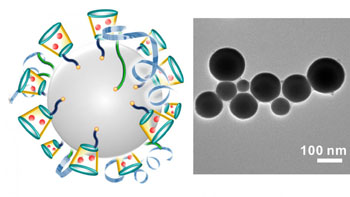Biodegradable Metallic Nanodrops for Safe Cancer Drug Delivery
By LabMedica International staff writers
Posted on 14 Dec 2015
A novel drug delivery system based on liquid metal nanodrops was used to safely transport the highly toxic chemotherapeutic agent doxorubicin (Dox) into the cancer cells comprising ovarian tumors in a mouse xenograft model.Posted on 14 Dec 2015
Although in use for more than 40 years as a primary chemotherapy drug, Dox is known to cause serious heart problems. To prevent these, doctors may limit the amount of Dox given to each patient so that the total amount a patient receives over her or his entire lifetime is 550 milligrams per square meter, or less. Furthermore, the necessity to stop treatment to protect the patient from heart disease may diminish the usefulness of Dox in treating cancer.

Image: A schematic illustration of the liquid-metal nano-terminators (left). The red spheres are the anticancer drug doxorubicin. A representative TEM image of the liquid-metal nano-terminators (right) (Photo courtesy of North Carolina State University).
Investigators at North Carolina State University (Raleigh, USA) and the University of North Carolina (Chapel Hill, USA) have incorporated Dox into nanodrops composed of a liquid-phase eutectic gallium-indium core and a thiolated polymeric shell.
The nanodrops were created by sonication of a bulk liquid metal (gallium indium alloy) solution that contained two types of polymeric ligands. The ultrasound treatment caused the solution to form minute droplets approximately 100 nanometers in diameter. The ligands in the solution attached to the surface of the droplets as they broke away from the bulk metal. Dox was then introduced into the solution where it attached to the nanodrops by binding to one of the surface ligands. The further attachment of hyaluronic acid to the nanodrops ensured that they would specifically target cancer cells.
Results published in the December 2, 2015, online edition of the journal Nature Communications revealed that when absorbed by the tumor, the higher level of acidity inside the cancer cells dissolved the oxidized skin of the nanodroplets. This released the ligands, which subsequently released the Dox inside the cells. In the mouse model, the nanodrop delivery system was significantly more effective than administration of Dox alone at inhibiting the growth of ovarian cancer tumors. Furthermore, after 90 days no signs of toxicity were found that were related to the liquid metal.
As a bonus, the liquid metal nanodrops reacted with the acidic environment in the cancer cells and dissolved to release gallium ions. These gallium ions enhanced the performance of anticancer drugs - including their effectiveness against drug-resistant cell lines.
"The advance here is that we have a drug-delivery technique that may enhance the effectiveness of the drugs being delivered, can help doctors locate tumors, can be produced in bulk, and appears to be wholly biodegradable with very low toxicity," said senior author Dr. Zhen Gu assistant professor in the joint biomedical engineering program at North Carolina State University and the University of North Carolina. "And one of the advantages of this technique is that these liquid metal drug carriers—or "nano-terminators"—are very easy to make. This was a proof-of-concept study, but very encouraging. Like the fictional Terminator, this carrier is transformable: smashed from bulk material, fused inside cancer cells, and eventually degraded and cleared. We are hoping to do additional testing in a large animal study to get closer to potential clinical trials."
Related Links:
North Carolina State University
University of North Carolina













